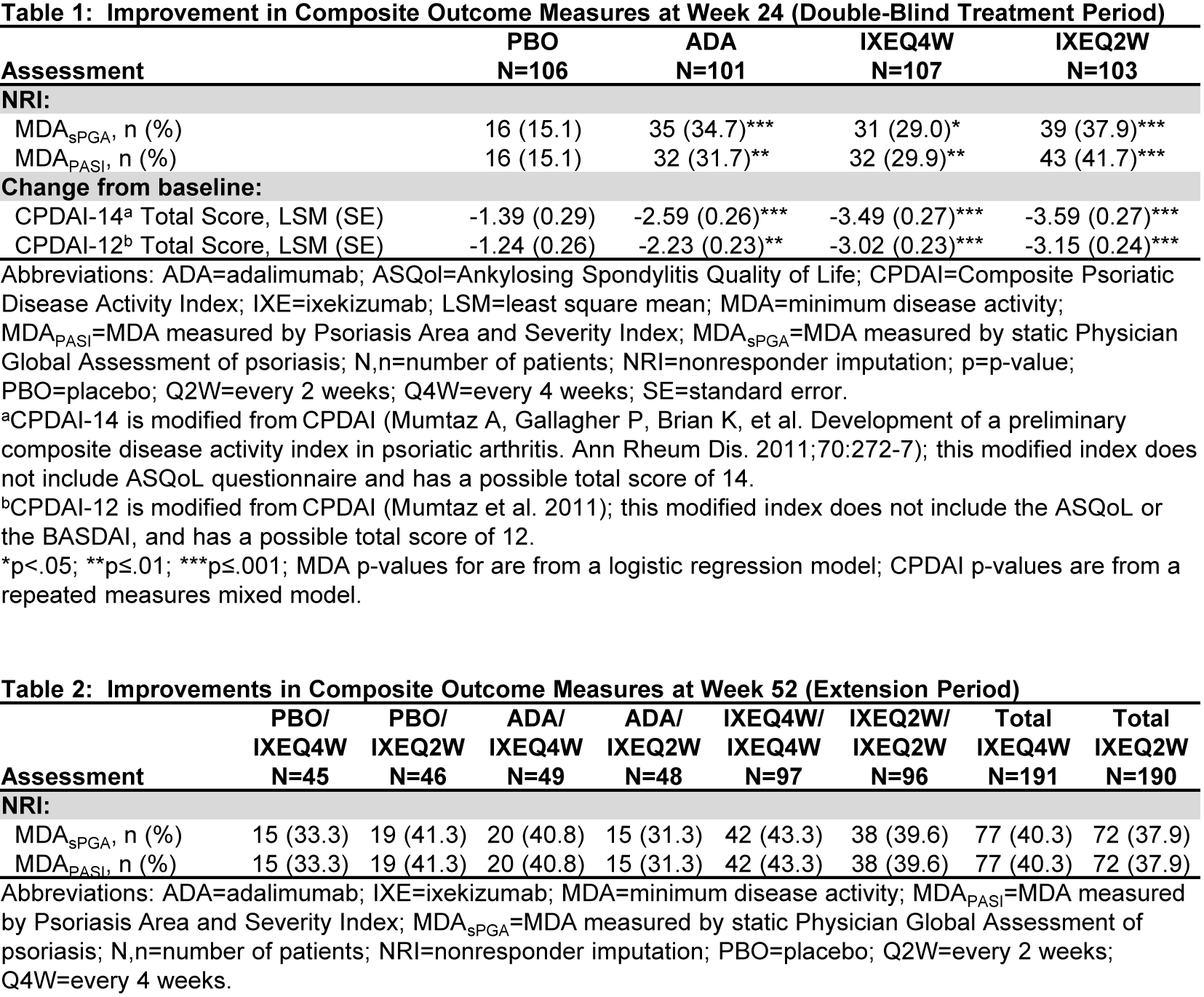Session Information
Session Type: ACR Poster Session B
Session Time: 9:00AM-11:00AM
Background/Purpose: PsA, a chronic immune-mediated inflammatory disease, can be progressive and destructive, resulting in physical deformities, impaired function, decreased quality of life, and increased mortality. Ixekizumab (IXE) is an IgG4 monoclonal antibody that binds with high affinity and specificity to the proinflammatory cytokine IL-17A. Data are presented from a phase 3 trial (SPIRIT P1; NCT01695239) with IXE in patients (pts) with active PsA. The objective is to explore the impact of IXE, as assessed by disease activity composite measures, up to 52 weeks (wks).
Methods: 417 bDMARD-naive adult pts with active PSA, were randomly assigned 1:1:1:1 to subcutaneous administration of either 80‑mg IXE every 4 wks [Q4W] or every 2 wks [Q2W], each with a 160‑mg starting dose at Wk 0; adalimumab (ADA) 40 mg Q2W [active comparator]; or placebo (PBO) in the Double‑Blind Treatment Period (DBTP; Wks 0-24). Of these pts, 381 continued into the Extension Period (EP; Wks 24-52). PBO- and ADA‑treated pts were randomly re-assigned (1:1) to 80 mg IXEQ4W or IXEQ2W at Wk 16 (inadequate responders) or Wk 24; ADA-treated pts started IXE, after an 8-wk wash-out period, at Wk 24 (inadequate responders) or Wk 32. Investigators were blinded as to the criteria for inadequate response. Disease activity was measured at Wks 24 and 52 by composite measures including the following: minimum disease activity (MDA) as measured with the Psoriasis Area and Severity Index (MDAPASI) and with the static Physician Global Assessment of psoriasis (MDAsPGA), and modified Composite Psoriatic Disease Activity Indices (CPDAI-12 and CPDAI‑14 [see Table 1 footnote]). Analyses for the DBTP were conducted on the Intent-to-Treat Population, defined as all randomly assigned pts; analyses for the EP were conducted on the EP Population, defined as all pts who received at least 1 dose of study drug during the EP. In the DBTP, treatment comparisons were made by a logistic regression model for categorical data with missing values imputed by nonresponder imputation; a mixed model for repeated measures analysis was used for continuous data.
Results: At Wk 24, CPDAI‑12 and CPDAI-14 total scores (assesses domains of peripheral arthritis, skin disease, enthesitis, dactylitis [and spinal disease for CPDAI-14 only]) for pts receiving IXEQ4W, IXEQ2W, or ADA, were significantly improved compared with results for pts receiving PBO (Table 1). Similarly, at Wk 24, significantly more pts receiving IXEQ4W, IXEQ2W, or ADA achieved MDAsPGA and MDAPASI compared with pts receiving PBO (Table 1), and percentages of pts receiving IXEQ4W or IXEQ2W who achieved MDAsPGA and MDAPASI were sustained through Wk 52 (Table 2). Results for MDAsPGA were similar to results for MDAPASI within each treatment group.
Conclusion: IXE provides sustained improvement of disease activity, as measured by various composite measures, for up to 52 wks in bDMARD-naive pts with active PsA.
To cite this abstract in AMA style:
Papp K, Gottlieb AB, Shuler CL, Burge RT, Cameron G, Kerr L, Mease PJ. Sustained Efficacy of Ixekizumab in Patients with Moderate-to-Severe Plaque Psoriasis and Concomitant Psoriatic Arthritis [abstract]. Arthritis Rheumatol. 2016; 68 (suppl 10). https://acrabstracts.org/abstract/sustained-efficacy-of-ixekizumab-in-patients-with-moderate-to-severe-plaque-psoriasis-and-concomitant-psoriatic-arthritis/. Accessed .« Back to 2016 ACR/ARHP Annual Meeting
ACR Meeting Abstracts - https://acrabstracts.org/abstract/sustained-efficacy-of-ixekizumab-in-patients-with-moderate-to-severe-plaque-psoriasis-and-concomitant-psoriatic-arthritis/

